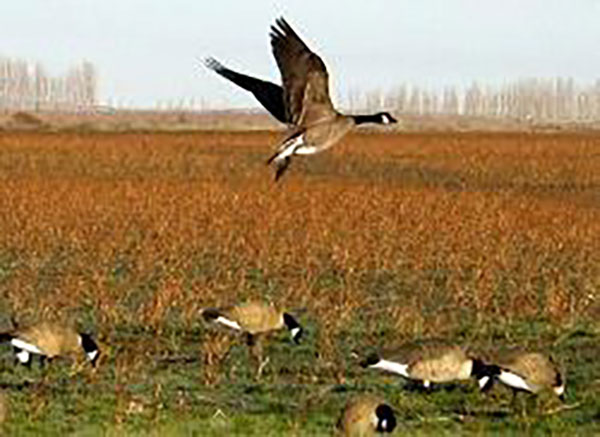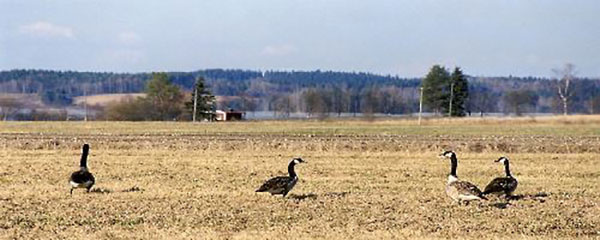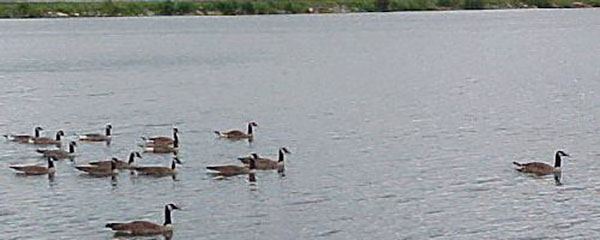FIND YOUR NEXT GUIDED HUNT AT HUNTTHENORTH.COM
Decoying Canada Geese – finding the perfect field
Decoying Canada Geese
By B.C. Maxima

A Five Part Mini-Series
- Overview: What It Takes To Be Successful
- Location: Finding the Perfect Field
- Concealment: Get Down And Cover Up
- Decoys and Calling: The Hard Facts
- The Hunt: Tying It Together
Part 2 Location: Finding the perfect field
“Boy I am sorry guys, you should have been here last week there were birds all over this field. I don’t know what happened, they must have moved out of the area….”
That statement is a direct result from A Lack Of Scouting! Unless you are directly adjacent to a major waterfowl refuge, it is a prerequisite that you scout your area each day prior to the hunt to consistently be successful. This article will give a detailed description on how to scout out a new area, pick the perfect field and how to attain permission on that field, as well as to give several tips on how to keep your field for the future.

Scouting A New Area
The first thing we need to do prior to hunting a new area or planning a trip is to sit down and make some phone calls to local biologists and conservation officers in the area to find out to what the average migration and local population of birds are expected to be during the regular season, as well as what the current weather conditions hold for that particular year. We are trying to identify a pattern of when the geese usually arrive and what kind of numbers we can expect to see.

Once we have found the area that we would like to hunt, we need to get lots of maps! Particularly, we need topographic maps, plat book maps and road maps for the entire area we wish to hunt. The importance of a current plat book is immeasurable along with a local phone book and cell phone for scouting purposes.
Once we have attained all of this information we are ready to plan a strategy. First off we need to get familiar with the area. This means either a trip out during the summer for a couple days to get a good feeling about our new area and to meet some of the locals, or if this is planning for a long distance trip, add an extra day or two for scouting prior to the hunt. Get one thing straight here, windshield time is a must. Do Not skimp on windshield time, it is the number one factor that will help you to be successful wherever you decide to hunt!
While out scouting our new area it is a good idea to research the local motels or resorts for lodging later in the year. Look for places that allow pets and cater to the hunting clientele. Most of the time a trip to the local café or restaurant is also worth while to speak with the locals about where the best goose hunting will be found later on.
Picking The Perfect Field

Now that we are familiar with our new area and the upcoming season is close at hand we need to tie up some fields to hunt. Another trip out to our favorite new area a couple weeks before the season starts is a great idea. We need to beat the crowd, so don’t wait until the day before opener and expect to get permission. Next we need to identify what the geese are eating and where they are roosting. This is where our topographic maps come into play. During the early goose season for example, most of the time the birds are feeding on wheat or alf alfa fields.
If we can find a field with this crop cover on it close to the roost, we should be in good shape. As the season moves on and the weather gets colder the diet of the birds will also change. Keep a careful watch to see how they’re feeding habits change. Scouting these fields about an hour after sunrise and before sunset is our best bet. However, don’t rely on just one field, make sure to tie up two or three spots and talk with the farmers that we have found using the plat books attained earlier this year, to see if they have any additional fields that may be good. Trust me, they want these geese gone as bad as you want to hunt them.
Now that we have a couple “Hot Spots” lined up ahead of time, we can feel much more confident showing up a day or two prior to the hunt to pick the field that looks the best. Ideally we are looking for a minimum of 100+ birds in a field to assure multiple opportunities. It is also very beneficial to have some field cover available to hide in. Even if ground blinds are being used, we need some cover to camo them up with. Next we also need to know what approximate direction we can expect the birds to come from….The Roost. This is very important to know especially on those days where there is little or no wind. And finally, we would like to be sitting in the exact spot the geese were the day before. Looking for fresh droppings and feathers on the ground assures us that they were in fact feeding in that spot recently. This will give us the best opportunity that the birds will return and want to land in the exact spot that we are “Located”!
Attaining Permission
To assure a quality hunting experience it is very important to be in the field that the birds want to be in. It is also hard to compete against other hunters or more importantly “The Real Thing”, which often happens when we are unable to get permission in the field we want. Several tools that will help us gain the edge over our competitors are; a current plat book, a local phone book and a cell phone that works. Often times the field that the birds are using is not easily accessible and that is why they are still there.

The owner may live several towns away or the farming rights are given to someone else. If you are able to contact the right person before the next guy you will have a much better chance of gaining access to that field. And don’t be intimidated by a “No Hunting” sign. Many times the land is posted to keep slob hunters off of it or because of a previous bad experience. A little kindness and respect can go a long way. Now that we have contacted the proper authority, we need to assure him that we are not slob hunters, that there will only be a couple hunters in his field and that we respect the land and the game we hunt. We also need to ask permission before we drive into the field and always ask if the farmer would like some of the game that we harvest. Even if they hate the taste of geese, the gesture will go a long way.
Keeping permission or attaining a lease on a certain piece of property is also a great way to assure your hunting success from year to year. Even if the prime field that kills birds every year already has hunters on it, it doesn’t hurt to inquire about the possibility of taking over a lease. Often times the current hunters may be disrespectful or unwilling to offer the landowner what the field is actually worth. It never hurts to ask. If you are lucky enough to attain the “Golden Field” don’t take it for granted. Offer to bring the landowner along on one of the hunts, offer your services around the farm for a day or just give him a call from time to time to check in. The last thing that a landowner wants to see is a disrespectful, ungrateful slob hunter who only cares about his own enjoyment.
In conclusion, it is always a good practice after the hunt is over to pick up after yourself which includes all shell casings and garbage as well as closing up any fences etc. It is also common courtesy to talk with the land owner afterwards about the hunt and bringing a gift, weather the hunt was a success or not, is a very nice gesture as well. A gift certificate to the local restaurant, a case of beer or just a simple thank you card will show your appreciation as well as leave a good taste in his mouth for the next time. Putting the landowner on your Xmas list is also a great way to build a relationship for the future. Again, a little kindness and respect goes along way………
Additional Tips From The Pro’s Articles
- Decoying And Calling: The Hard Facts!
- Decoying Canada Geese – Decoying Canada Geese
- Retrievers & Chiropractic – Can An Animal Chiropractor Help?
- Retriever Performance Events And Why You Should Care
- The Scent Control Debate
- Ten Tips For A More Successful Pheasant Hunt
- Wanton Waste Laws – What Do They Mean & Why Do They Exist?
- How To Get Started Bow Hunting
- The Perfect Deer Rifle
- Exercise Induced Collapse (EIC) In Retrievers – Hunters Beware!
- A Guide To Tipping Your Guide
- Are Canada Geese Actually Getting Smarter Each Fall?
- Top 5 Criteria To Look For in A Fishing Report
- How High Is Too High?
- Turkey Hunting Tips And Tactics
- Realistic Expectations For A Quality Guided Spring Snow Goose Hunt
- Conditioning Your Retriever For The Upcoming Season
